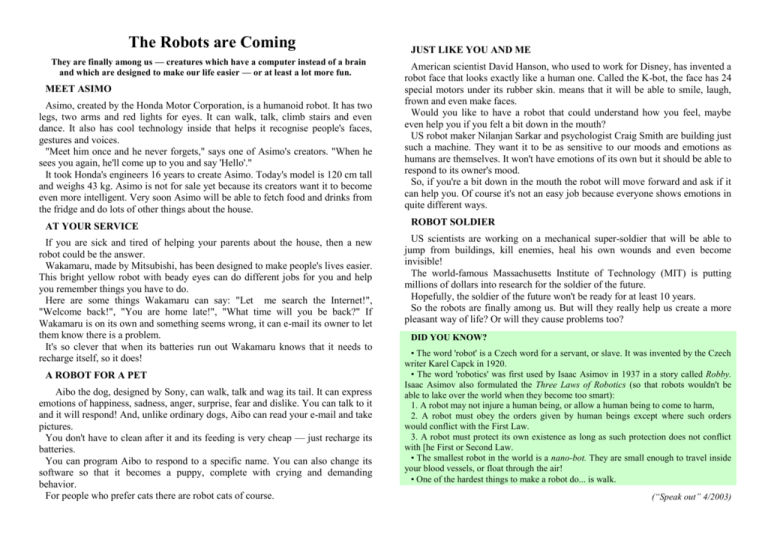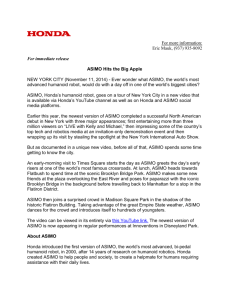The Robots are Coming
advertisement

The Robots are Coming They are finally among us — creatures which have a computer instead of a brain and which are designed to make our life easier — or at least a lot more fun. MEET ASIMO Asimo, created by the Honda Motor Corporation, is a humanoid robot. It has two legs, two arms and red lights for eyes. It can walk, talk, climb stairs and even dance. It also has cool technology inside that helps it recognise people's faces, gestures and voices. "Meet him once and he never forgets," says one of Asimo's creators. "When he sees you again, he'll come up to you and say 'Hello'." It took Honda's engineers 16 years to create Asimo. Today's model is 120 cm tall and weighs 43 kg. Asimo is not for sale yet because its creators want it to become even more intelligent. Very soon Asimo will be able to fetch food and drinks from the fridge and do lots of other things about the house. AT YOUR SERVICE If you are sick and tired of helping your parents about the house, then a new robot could be the answer. Wakamaru, made by Mitsubishi, has been designed to make people's lives easier. This bright yellow robot with beady eyes can do different jobs for you and help you remember things you have to do. Here are some things Wakamaru can say: "Let me search the Internet!", "Welcome back!", "You are home late!", "What time will you be back?" If Wakamaru is on its own and something seems wrong, it can e-mail its owner to let them know there is a problem. It's so clever that when its batteries run out Wakamaru knows that it needs to recharge itself, so it does! A ROBOT FOR A PET Aibo the dog, designed by Sony, can walk, talk and wag its tail. It can express emotions of happiness, sadness, anger, surprise, fear and dislike. You can talk to it and it will respond! And, unlike ordinary dogs, Aibo can read your e-mail and take pictures. You don't have to clean after it and its feeding is very cheap — just recharge its batteries. You can program Aibo to respond to a specific name. You can also change its software so that it becomes a puppy, complete with crying and demanding behavior. For people who prefer cats there are robot cats of course. JUST LIKE YOU AND ME American scientist David Hanson, who used to work for Disney, has invented a robot face that looks exactly like a human one. Called the K-bot, the face has 24 special motors under its rubber skin. means that it will be able to smile, laugh, frown and even make faces. Would you like to have a robot that could understand how you feel, maybe even help you if you felt a bit down in the mouth? US robot maker Nilanjan Sarkar and psychologist Craig Smith are building just such a machine. They want it to be as sensitive to our moods and emotions as humans are themselves. It won't have emotions of its own but it should be able to respond to its owner's mood. So, if you're a bit down in the mouth the robot will move forward and ask if it can help you. Of course it's not an easy job because everyone shows emotions in quite different ways. ROBOT SOLDIER US scientists are working on a mechanical super-soldier that will be able to jump from buildings, kill enemies, heal his own wounds and even become invisible! The world-famous Massachusetts Institute of Technology (MIT) is putting millions of dollars into research for the soldier of the future. Hopefully, the soldier of the future won't be ready for at least 10 years. So the robots are finally among us. But will they really help us create a more pleasant way of life? Or will they cause problems too? DID YOU KNOW? • The word 'robot' is a Czech word for a servant, or slave. It was invented by the Czech writer Karel Capck in 1920. • The word 'robotics' was first used by Isaac Asimov in 1937 in a story called Robby. Isaac Asimov also formulated the Three Laws of Robotics (so that robots wouldn't be able to lake over the world when they become too smart): 1. A robot may not injure a human being, or allow a human being to come to harm, 2. A robot must obey the orders given by human beings except where such orders would conflict with the First Law. 3. A robot must protect its own existence as long as such protection does not conflict with [he First or Second Law. • The smallest robot in the world is a nano-bot. They are small enough to travel inside your blood vessels, or float through the air! • One of the hardest things to make a robot do... is walk. (“Speak out” 4/2003)





